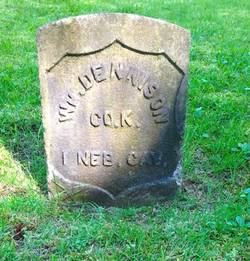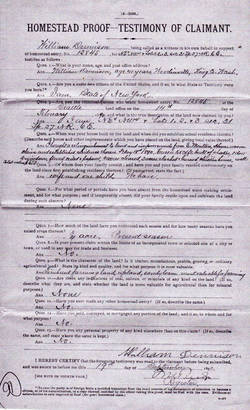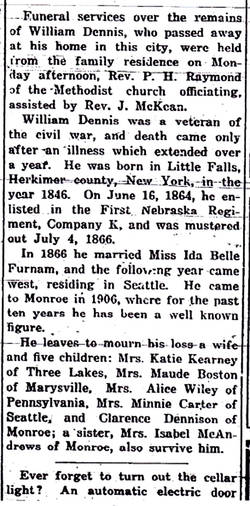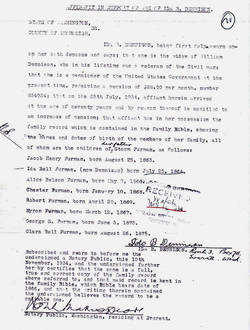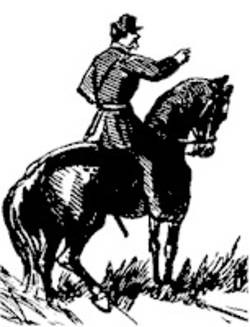William Dennison
Representing: Union
G.A.R Post
- Lucius Day Post #123 Monroe, Snohomish Co. WA
Unit History
- 1st Battallion Nebraska Cavalry K
Full Unit History
1st NEBRASKA VOLUNTEER CAVALRY
Organized: Spring/Summer, 1861
Mustered In: 6/11 - 7/21/61 Omaha, NB Terr.
Mustered Out: 7/1/66 Omaha, NB
Regimental History
REGIMENTAL HISTORY:
This three year western theater regiment began life as an infantry unit. Recruited from the territory at large, the 1st rendezvoused at Omaha from whence, after Federal muster, part of the organization embarked for St. Joseph, MO and from there to St. Louis, then on to Pilot Knob where, in mid-August, 1861 it was joined by the rest of the regiment. Scouting after Rebel bushwhackers at various points in Missouri followed.
In early February, 1862 the 1st departed winter quarters at Georgetown, MO to travel to Ft. Henry in Tennessee. After the capture of that stronghold, the unit moved on to Ft. Donelson.
The 1st was next in action on April 7, 1862 during the second day of fighting at Shiloh/Pittsburg Landing, TN. During this bloody engagement the regiment suffered 4 men killed, 5 officers and men wounded and 2 men missing.
The regiment next participated in the advance upon and siege of Corinth, Mississippi after which it was ordered to Memphis, Tennessee. One week later it headed for Helena, Arkansas where it was involved in several scouting expeditions before moving back into Missouri. Several severe marches were then endured during the winter of 1862/'63.
March, 1863 saw the 1st ordered to Cape Girardeau, MO. It was active there in April after which it pursued the troops of Confed. Gen. Marmaduke which led to combat engagements at Chalk Bluff and St. Francis River. Guard, picket and fatigue duties intervened until late August when a move was made back to St. Louis where the regiment encamped.
While at St. Louis the 1st was recruited to a full complement men and refitted as a cavalry unit. In November, 1863 the cavalry 1st was assigned to the District of Arkansas. Arriving at Batesville, Arkansas on December 25th the unit was involved in scouting and picket activities until the third week of January, 1864.
While at Batesville the 1st charged the enemy at Jacksonport where a number of Confederates were killed and some prisoners taken. Mere days later a detachment of the regiment was involved in a three day running fight with the enemy in the Sycamore Mountains. Other activity preceded a sharp skirmish with Confederates at Jacksonport. It continued skirmishing and scouting in that area until late May, 1864 when it moved to Devall's Bluff, Arkansas. That summer the reenlisted veterans went home on furlough.
With veteran volunteer furloughs over, the 1st was assigned to duty in Nebraska with headquarters at Ft. Kearney. In September of that year a detachment went on a scout after hostile Indians on the Republican and Solomon forks of the Kansas River. During this movement the regiment marched 800 miles in 23 days.
With the War ended, during the remained of its term of service the regiment was dispersed by detachments to different points within Nebraska. Assignments until final muster included engaging in scouting and escort duty, guarding the overland mail and state routes and confronting bands of hostile Indians in frequent skirmishes.
Soldier History
SOLDIER:
Residence: Omaha, NB Terr. Age: 17.6 yrs.
Enlisted/Enrolled: 7/11/64 Omaha, NB Terr. Rank: Pvt.
Mustered In: 7/11/64
Mustered Out: 7/1/66 Omaha, NB Terr.
Discharged: 7/1/66 Omaha, NB Terr.
Highest Rank: Pvt.
Family History
PERSONAL/FAMILY HISTORY:
William K. Dennison was born December 12, 1846 in Little Falls, Herkimer County, New York to John (b. 1814 Ireland) and Catherine (nee MaCaffery b. 1823 Ireland) Dennison. The Dennison’s emigrated to America sometime between 1839 and 1841. As far as can be determined he was the youngest of five children: Mary (b. 1846 Ireland), John, Jr. (b. 1839 Ireland), Isabella/Isabelle (b. 184l NY), and Margaret (b. 1843/'44 NY) and William.
At the time of the 1850 U.S. Census the Dennison’s were still residing in Little Falls, NY where William's father was noted as a "factory man." A decade later the family was in Tipton, Cedar County, Iowa with Mr. Dennison listed as being a farmer. Thus, for at least a portion of his younger years William was a farm boy.
In July of 1864 the teenaged William enlisted in the U.S. Army cavalry. At that time his place of residence was noted as Omaha, Nebraska Territory. Whether he had moved there with his parental family or had left home and travelled there on his own is not documented.
It appears that Private Dennison's near two years of military career were fairly benign as only two absences are listed during his period of service. On 12/24/64 he was hospitalized at U.S. General Hospital Ft. Kearny, Kansas for a contusion. He returned to duty on 12/30/64. The second was for being on escort duty. Years later, it would be claimed he lost a portion of his right index finger in battle. That injury, however, is not reflected in his military medical records.
Although William's military discharge came in Omaha, where he settled after being separated from the army is not known. In fact, as with many other Civil War veterans, his whereabouts are not documented at all for many years.
The first post-war documentation on William comes from 1888 when, on the twenty third of August, in his old hometown of Tipton, Iowa he married to Ida Belle Furman. (Note: A number of different birth years exist for Ida. Most likely, however, she was born 7/25/64 in New York.) The Union would produce eight children; Katie May (b. 2/28/89), Walter (b. 7/16/90), Maudie (b. 6/25/91), William Naltio (b. 7/16/92 - deceased by 12/23/97), Alice Francis/Frances (b. 12/19/94) Maude "Maudie" Mabel (b. 6/29/96), Minnie (b. 2/15/98) and Clarence Valentine or Valentine Clarence (b. 2/14/00).
In late 1889 or early 1890 the Dennison’s left Iowa and moved westward to the Puget Sound area of western Washington State. It appears the move was made because of the availability of an existing homestead tract in or near the community of Woodinville located northeast of Seattle. Available documents indicate that a purchase agreement on the property, which included a house, from on E. Moulton, occurred on 2/14/90. Settlement thereon by William, his wife and one child occurred. Four days later. On 5/27/90 notice for purchase of the 169.40 acres of land was posted and printed in Snohomish County.
On 9/19/919 William applied to the Seattle land office for final okay on purchase of the homestead property. The cost would be $1.25 per acre ($200). At that time it was noted that 3/4 of an acre had been cultivated for the present season. An additional 4 acres had been cleared with 3 slashed and burned. Apparently a larger, 16' x 24' house had been built, a henhouse constructed and a well dug. Total value of the site was $600. Although no document is available, final purchase of the homestead was apparently granted.
The next known address for the family comes from 10/29/92 when they were residing in or near the Snohomish County community of Marysville. Just short of five years later, however, on 7/17/97 they were southeast of there in King County living east of Seattle and Lake Washington in in or near Kirkland.
Available documentation points to the year 1897, while in Kirkland, that former Civil War soldier William Dennison began petitioning the U.S. Government for receipt of a disability pension based on ailments which had begun some years earlier, but which he traced back to his days of soldiering. These included heart problems which had begun as early as 1866, failing eyesight which onsetted around 1888 as well as rheumatism, kidney disease and general "debilities," the latter three which began circa 1892. All contributed to the 51 year old unable to perform manual labor.
In March of 1898 William's initial pension request was rejected. This, however, did not conclude his efforts to become pensioned. Thus, in early December, 1902 a monthly pension stipend of $6 per month. By that time, the laundry list of ailments also included the onset of deafness. In October of the following year a doctor's examination reported the following conditions afflicting Mr. Dennison: Piles, chronic rheumatism, chronic indigestion, chronic cystitis, loss of index finger of the right hand as well as sight and hearing problems due to old age. At death the monthly stipend would be $6.50 per month.
While the pension process was being pursued, the Dennison’s were again on the move. By 1900 they had moved from Kirkland in King County back to the Tulalip are of Marysville in Snohomish County. Finally, around 1906 the family settled for the final time in the Snohomish County community of Monroe. It was there on September 15, 1916 that William Dennison died from what his Monroe Monitor obituary noted only as "an illness which extended over a year." He was survived by his wife and five children: Mrs. Katie Kearney of Three Lakes, Mrs. Maude Boston of Marysville, Mrs. Alice Wiley of Pennsylvania, Mrs. Minnie Carter of Seattle and Clarence Dennison of Monroe. Also living was his sister Isabel McAndrus of Monroe. Burial was in the Monroe I.O.O.F. Cemetery.
The month following her husband's passing Ida requested that she allowed to continue receiving at least a portion of her late husband's Civil War pension. That the request was granted is evidenced by that fact at death she was receiving a monthly stipend of at least $28.50. (The awarded amount was $30, but was reduced 5% due to the "economy law." She died on May 7, 1943 and buried beside William in Monroe.
Cemetery
Buried at IOOF Cemetery in Monroe
Row: Old
Site: E28
